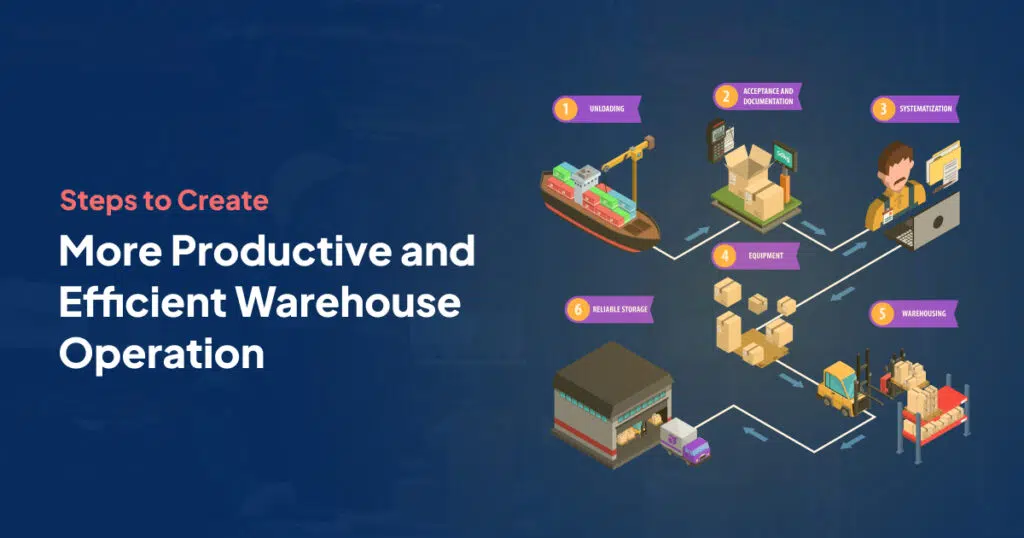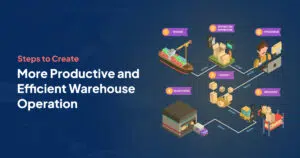Most warehouses strive continually to improve productivity by cutting down on wasted time and materials via the use of automation technology. There are numerous strategies to increase warehouse efficiency. Still, it isn’t always clear which ones will provide the most outstanding results since warehouses are complicated processes with many moving components and activities occurring concurrently.
Innovations in artificial intelligence and machine learning, cutting-edge warehouse management software, and other technological advancements have a significant influence on warehouse productivity. Looking at your present processes and systems to identify bottlenecks and other problems, implementing process changes, and making sensible technology investments that address your core difficulties put organizing a warehouse and enhancing warehouse efficiency within reach. These tips range from management and leadership guidance to suggestions for enhancing your warehouse’s physical design, layout, and processes.
Why Will 2023 Warehouse Efficiency Be So Important?
Better efficiency in the rest of your supply chain, including fulfillment and shipping, directly results from well-managed warehouses. Unanticipated problems are common in the supply chain of online retailers. For example, the worldwide supply chain disruption brought on by the COVID-19 epidemic.
Many e-commerce companies had significant difficulties maintaining their supply chains as national lockdowns effectively slowed down or prevented the flow of completed items and raw materials equally. Since many online retailers were unprepared for some supply chain constraints, the epidemic brought them into sharp relief.
72% of Ernst & Young poll respondents felt that the pandemic hurt their organization. Among those who responded, just 2% were entirely ready for the epidemic. A lack of available workers disrupted supply networks worldwide even after the epidemic subsided. There were a lot of available positions in the warehousing industry.
By late 2021, clogged ports were typical since there were no personnel to unload cargo. Because of a lack of staff, more than 70 container ships could not leave the Los Angeles and Long Beach ports. If your warehouse isn’t operating as effectively as it may be, the task will be much more difficult.
1. Analyze Results
You cannot fix a problem until you identify its causes. You must conduct an investigation. It would help to evaluate how well you are using your resources. Do items enter and leave the facility regularly? It is understood that a warehouse’s layout has a direct impact on its efficiency. Still, a disorganized warehouse may slow down your personnel and pose a number of safety issues if it is not maintained correctly. Make sure your employees are following all necessary steps and using the most direct paths through the warehouse at all times. Using RFID technology to keep track of where everything is in the warehouse may improve security and save search times.
Product tracking by hand is too time-consuming and labor-intensive to be practical in today’s warehouses. Products in a warehouse may be tracked and identified with the use of technological innovations like radio frequency identification (RFID) and barcodes. Using RFID, you can monitor your stock from the moment it enters your warehouse until the moment it departs. More data than can fit on a barcode is stored safely in one of these tags. Furthermore, RFID tags’ radio components may either passively broadcast data or need a reader to access the data.
Barcodes also save time and enhance accuracy by minimizing the effort workers need to identify the needed product. Barcodes are more accessible to produce and use because they do not need as much room on the packaging as RFID tags do. Barcodes continue to offer warehouses a cheaper form of inventory monitoring for the time being despite the fact that many organizations are switching to RFID technology.
2. Create An Environment Where Production Is Rewarded
It would help if you aimed for an exciting, innovative, and enjoyable culture in the warehouse since it will affect the company’s performance in every way. In addition to soliciting novel suggestions from workers, you should also devise methods of keeping them actively involved in their jobs.
Customer discontent brought on by shipping mistakes might have a negative impact on future purchases. They also take up a lot of internal resources to set right since processes need to be followed out to fix these blunders. There will be fewer cases of erroneous goods being sent to a consumer thanks to tracking identifying technology. Using radio frequency identification technology, a warehouse may better guarantee that only the proper products are transported to the correct clients. The time it takes to sort products once they have been sent decreases as well.
Managers must have the necessary skills and knowledge to maximize productivity. In order to fix issues quickly and efficiently, this should be a continuous process that includes evaluations, updates on new technologies, and input from users. Information freedom promotes safety, productivity, and participation. When monitoring assets using RFID technology, bottlenecks, and missing goods become more evident and may thus suggest if training is required in particular parts of the warehouse to fix this.
3. Technology
Even if you’re not highly computer-aware, the newest technology may convert your firm into a high-efficiency warehouse. Examples of such systems include warehouse management software (WMS), which may significantly improve workflow by facilitating the smoothest, most economical flow of products and resources possible. It achieves this by monitoring warehouse layout, stock control, product picking and packaging, storage, shipping, employee scheduling, yard and dock operations, and data reporting.
Do you use “standalone WMS software” or an on-premises legacy application? Problems and increased manual labour are familiar with such systems. The finest warehouse management system (WMS) for any company is a cloud-based solution.
There are many additional remarkable warehouse technologies available. One option is to use voice-enabled devices. Order pickers may now be more productive without wasting time reading order papers or waiting for managers to give them verbal instructions; instead, they can listen to their headphones and be told where to go, what to select, and where to deliver it.
Manual pickers may be adequate for a small business, but as your warehouse expands, they may become inefficient. Think about it: When routes are optimised, a human order picker can select 60–80 items per hour; with automation, such as sorters and conveyors, that number may rise to about 300 items per hour.
Automating order-picking processes will increase efficiency and reduce labour expenses, making the initial investment worthwhile. Specifically, automated and efficient warehouses are statistically more likely to achieve 99% inventory accuracy, lower labour costs by an average of 3% annually, and reliably dispatch orders within one day of placing by a factor of 40%, as reported by Robotics Business Review.
4. Make use of a Logistics Hub
You may see now that you’d prefer not to work in the logistics industry. Then, it would help to consider using a 3PL fulfilment centre for your logistical needs. A fulfilment centre manages your items’ warehousing, picking, packaging, and shipping, along with returns management, customer care, and more. They provide several advantages for online retailers, including:
Reduced expenses. Outsourcing to a 3PL may save money on rent, utilities, and other overhead costs and minimise or eliminate the need for physical storage space. The 3PL’s established contacts with carriers might reduce shipping costs.
Experience. A 3PL is a logistics expert. By using their services, you may use their cutting-edge tools and the expertise of their staff.
Global Reach. For fear of breaking foreign laws and regulations, several online retailers never expand outside their country. Many 3PLs operate on a worldwide scale, enabling companies to contact customers all over the world.
Helping Out Customers. A third-party logistics provider (3PL) has the workforce to manage customer orders, including returns, swaps, and refunds.
Scalability. Shipping delays and unhappy customers result from insufficient storage capacity and increased demand as your company expands. As your business expands, a 3PL may store and distribute your product from wherever is most convenient for them.
Conclusion
Some of these suggestions may call for extensive renovations to your warehouse. You must be aware of the current state of your operations in relation to your goals. Find places where you can save money and shorten employees’ workdays. When planning upgrades for your building, focus on these areas first.







